In the light of anything exciting to read in the Tech Section, I thought I would cobble something together about my S1...
Some of you may know that I have a 97 S1, with the super sexy smaller tank. I chose to keep this in preference to an S1W, which is now under the loving care of restone.
Anyway, those of you that know their stuff about Tubers will be aware that the 96 and 97 S1s (aswell as other Tuber models of the same era) came with
Lightning heads. These have a 10 degree squish band, mated to a flat topped piston, which basically equates to poor performing combustion chamber, which is prone to knock. The later Thunderstorm heads came with a 15 deg squish band, and a piston to match, in addition to a bigger inlet valve. The squish band was a token effort, being cast into the head, rather than machined, so is a little compromised, but it has the right idea, trying to force the last bit of mixture up towards the plug, from where the flame kernel is growing. All the White Lightnings, Lightning Strikes, later M2s, later S3s and X1s came with these heads. If you read the 25 Years of Buell book, coupled with a 200RPM higher rev limit, they are worth 10bhp.
When the XB came along, the head design was changed, probably as part of a cost cutting exercise. The 15 deg squish band was reduced to a 0 deg squish band, or put another way, a flat face.
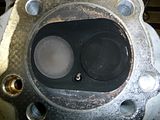
The head design also had better flowing ports... And again, using 25 Years of Buell, coupled with a fuel injection system and a more configurable ignition map, this was worth another 2bhp.
In addition to these changes, the position of one of the bosses for the front engine mount also changed and the carb mount bosses/breather holes were not drilled and tapped, meaning it was not so easy to retro-fit them.
From the word go, my S1 was a great bike to ride, the CV carb had obviously been set up by someone who knew what they were doing (the Mikuni that I later fitted was no better for throttle response). It felt nicer to ride than my Firebolt (91bhp on Tubbs dyno) and Daywalker and I were surprised when it only made 80bhp.
Some months before getting the S1 on the road, I had picked up some XB9, cylinders, pistons, heads, rocker boxes and rocker box covers on EBay. These sat on the shelf for nearly a year. During that time, I went through a "Oh no I have no money" period and I tried to sell them to robs, he didn't like my price and ended up getting some from the states (which he sold on in preference to Thunderstorm pistons and heads).
Also during this time, I got a front engine mount off spondon440 (as the original mount was never going to fit) in readiness for... well something...
*** I need to say here that nothing that follows is new - Steely has done the same and more on his Sportster, O3 has a similar setup on his M2 Razorback and I am sure other people have gone the same way ***
A few months ago, I was sick of seeing them gathering dust in my grease-eater, and egged on by Gunter and Daywalker, I decided to get them fitted.
First job was to machine the carb bracket bosses (it was going to breathe through the XB PCVs in the rocker covers), so taking measurements off my Lightning heads, I used my old man's Bridgeport to face off, drill and tap the bosses.
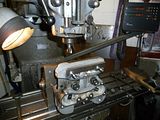
I then lapped the valves in and replaced the valve stem seals.
The next thing to think about was what pistons to use. I had a set of XB9 pistons, however, there were three reasons I did not want to use them, certainly in their stock shape. Firstly, the crown has a design flaw, that being the bulges on the eyebrows for both valves, this means that the piston to head clearance is going to be limited at these points and hence the clearance at the crown sides, where the majority of the squish area is, will be large.
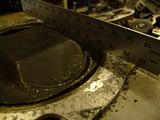
Secondly, the crown shape, along with the increased stroke of the 12, would result in a compression ratio knocking on the door of 13:1 with a decent squish clearance. Thirdly, when I tried them in the S1 cylinders, I found the the cylinders and pistons were 10 thou oversize

Gunter sent me some pictures of 9 and 10 piston crowns for my education, and the dimensions of the nipple on the top of the, otherwise flat topped, 12 pistons. So I was all set to machine the 9 piston crowns to make them into pseudo 12 pistons, but a voice at the back of my head (a bit like Herne the Hunter in Robin of Sherwood) said "no", get some 12 pistons, or some posh pistons from NRHS.
Now, I am largely a fan of making the stuff from the factory work better, I am not really into big bore kits, cams, nor posh pistons, not for the road anyways, so I opted for what I knew would be reliable, a set of standard XB12 pistons. Of course, I could have used the S1 cylinders and pistons, but I wanted that nipple for more compression ratio...
Herne was right though. Measuring the crown thickness of the 9 and the 12 showed that machining the crown of the 9 to drop the compression ratio was not a good idea...
The next thing on my mind was some new cylinders, after all, XB pistons don't some oversized, at least not in the parts book. I don't think I have seen any come up on EBay.co.uk, but there are plenty at places like Pinwall in the states. Just prior to taking the plunge and ordering a set, Herne the Hunter turned up and said "look at the XB9 cylinders, understand how they differ from the 12", so like a good boy of the forest, I checked the cylinder length, and also the part number. Wow, I was astounded, they were the same part as the 12, so too were the pushrods (which I haven't used), which means the only real difference between 9 and 12 in this area is the crank, the con rod (longer on the 9) and the piston... Nice to know...
I honed the cylinders and checked the 12 ring gaps, all was in order...
Using guidance from the NRHS website and Tubbs, I armed myself with some Cometic gaskets (10 and 20 thou base and 30 and 40 thou head), the 9 cylinders, 9 heads, the 12 pistons, some grease and some 1.1mm diameter solder.
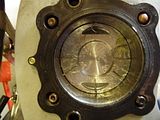
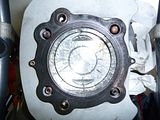
I selected my gaskets to ensure I had a min squish clearance of 30 thou, however, I had to repeat the job cos I cottoned on to the fact that the small folded paper in the Cometic package was actually some instructions, and the torque values used were somewhat higher than Erik tells us to use. I ended up with a further 10 thou on the base gasket to get the clearance right.
In actual fact, I ended up between 36 and 40 thou as a result of concentricity errors from the crank centreline to the head face, the connecting rod bearing centreline parallelism and the wrist pin centreline to piston crown parallelism. I was limited to a minimum of 36 thou cos of the minimum step in gasket size was 10 thou, I could have done with a 5 thou base gasket or, if I was feeling really adventurous, could have marked the pistons at their tightest spot and then pulled them down with a draw bar onto shim material on a face plate on the lathe, then "squared" the face up... Maybe a job for another engine build project...
I then checked my eyebrow clearance using some modelling clay. Even though this was essentially a stock setup, Tubbs hammered into my brain not to take any chances, and I'm glad I took note.
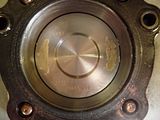
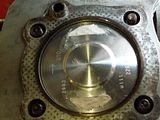
The front exhaust clearance was a little low (less than 60 thou) at the top of the pocket, so out came the Stanley knife to get the desired value.
The S1 gives you access to do all this with the engine in the frame, I'd love to repeat the exercise on my Firebolt, but it would be a frame-off-job...

When I bought the bike, it came with adjustable pushrods and collapsible covers. Maz warned me it was potentially a grenade engine, but what could I do? Well, I pulled the cams out and they appeared to be stock, the first dyno run suggested it was nothing special, but I digress...
Anyway, those of you that have played with adjustable pushrods will know a bit about the tappets too and how to set them up. Bascially, the tappets have 0.2" of self adjustment, so based on this "fact", and with the engine on the compression stroke, but some way either side of TDC, the adjustable pushrod is extended by hand until it goes tight. Then, allowing the tappet to bleed down throughout the process, the pushrod is extended a further 0.1", commonly done by a knowledge of the thread pitch (mine were 25TPI) and hence the increase in length per 6th of a turn (a nut flat). Just to make sure I was on the right track, when fully adjusted, I took the pushrods out and measured them against stock. They were close to 2mm shorter than both the S1 length in the manual, the XBs and some I had kicking around from a Sportster engine which were all the same length. I was a little concerned, so I set them up again, and they were still a similar amount different. So, what was that telling me? Either the tappets have more than 0.2" of travel or the stock pushrods are longer than they need to be... Or my adjustable pushrods are shorter than they need to be

Anyway, I drew stumps and get the rest of the engine together, finishing on the Thursday before Em's day. Took it for a 20 miles test that evening, then with it holding together, apart from an oil leak from the plugged oil gallery which I cut through when cutting down the cam cover (take note pre-98 engine owners - I later fixed this by drilling and tapping the hole 1/4 UNC and Loctite Hydraulic Seal-ing it in), I rode it to East Kirkby and back, a good 400 miles, to do the running in...
Then I took it to Tubbs to tinker on the dyno:
viewtopic.php?f=8&t=7732The results were encouraging. Of note was the ignition timing. The standard ignition curve had too much advance for the engine. If we assume that Erik did a good job at the factory by selecting the optimum curve for the combustion chamber, the engine response to a reduced advance suggests that combustion occurs faster. I am down to 30 deg advance (see
this post) from 5250rpm onwards at WOT. Compare this to an XB and you will see that the XB ECM demands a few degrees more. Does it need it?

Of course, it is not as simple as all this, the ignition timing advance is set to burn all the mixture as close to Top Dead Centre as possible. Many things affect the flame speed, such as AFR, temperature, pressure (volumetric efficiency - how well the cylinder fills) and flow inside the combustion chamber (this is where squish and other methods of provoking mixture movement - such as swirl and tumble - help). The difference between what works on my S1 and what Erik wanted on the XB could therefore be down to volumetric efficiency as the exhaust / inlet cam profile is different.
So all in all, and well over 1000 miles later, well worth the fannying about to get things to work (sure, you can use 2003 Sportster heads - but try finding them second hand).
Next on the to-do list is to get the engine to talk to an XB ECM so I can have better control over the ignition, I think I can get away with even less advance, especially in the midrange. I also want to ditch the VOES and replace it with a MAP sensor or MPX4115A which will act as the TPS input to the ECM, then it will be off to the dyno again to make it work...












